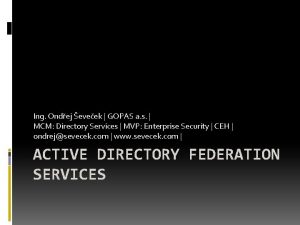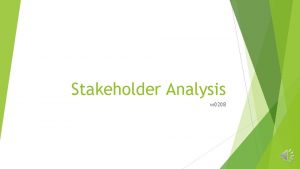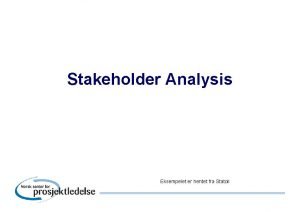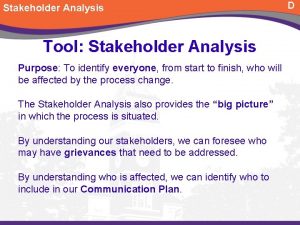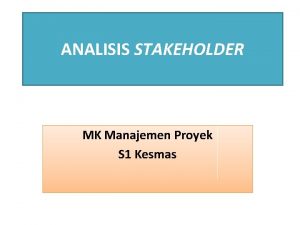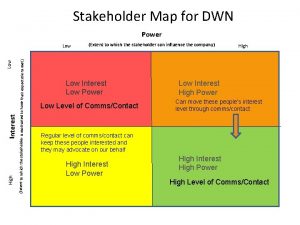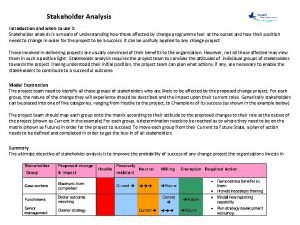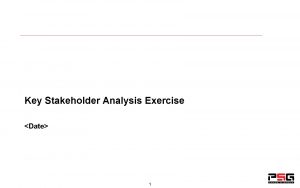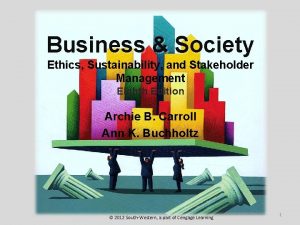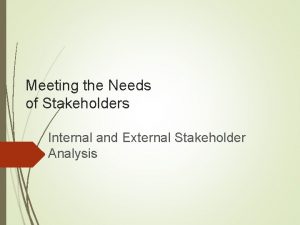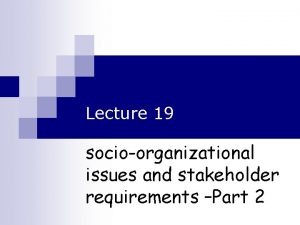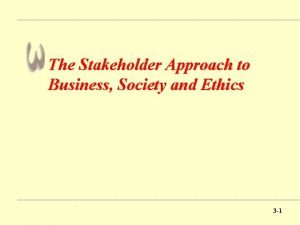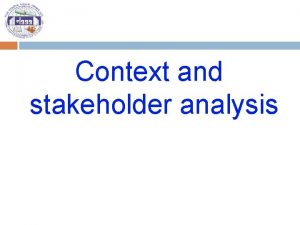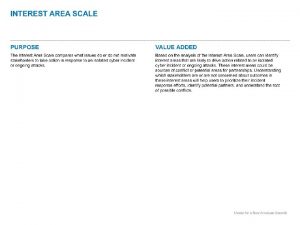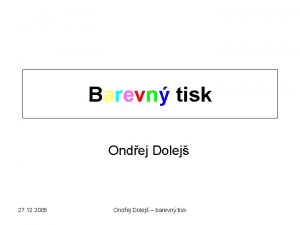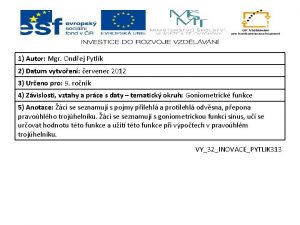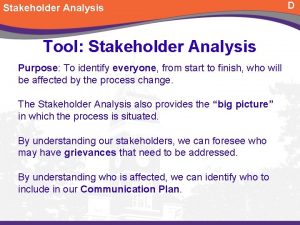Stakeholder approach and stakeholder analysis Ondej stek castekecon





![www. econ. muni. cz Who is a stakeholder Authors, year Stanford Research [1] Institute www. econ. muni. cz Who is a stakeholder Authors, year Stanford Research [1] Institute](https://slidetodoc.com/presentation_image/885774b8f446e983aa70eb20894f0ac7/image-6.jpg)
![www. econ. muni. cz Authors, year Definitions (Stakeholders are. . . ) [8] Freeman www. econ. muni. cz Authors, year Definitions (Stakeholders are. . . ) [8] Freeman](https://slidetodoc.com/presentation_image/885774b8f446e983aa70eb20894f0ac7/image-7.jpg)
![www. econ. muni. cz Authors, year Definitions (Stakeholders are. . . ) [15] Freeman www. econ. muni. cz Authors, year Definitions (Stakeholders are. . . ) [15] Freeman](https://slidetodoc.com/presentation_image/885774b8f446e983aa70eb20894f0ac7/image-8.jpg)
![www. econ. muni. cz Authors, year Definitions (Stakeholders are. . . ) [22] Wicks www. econ. muni. cz Authors, year Definitions (Stakeholders are. . . ) [22] Wicks](https://slidetodoc.com/presentation_image/885774b8f446e983aa70eb20894f0ac7/image-9.jpg)











![www. econ. muni. cz Stakeholder attributes Savage et al. [1] propose two attributes: n www. econ. muni. cz Stakeholder attributes Savage et al. [1] propose two attributes: n](https://slidetodoc.com/presentation_image/885774b8f446e983aa70eb20894f0ac7/image-21.jpg)














- Slides: 35

Stakeholder approach and stakeholder analysis Ondřej Částek castek@econ. muni. cz 1

www. econ. muni. cz Content 1. 2. 3. 4. 5. 6. 7. 8. 9. Shareholder and stakeholder approach A move between these approaches Who is a stakeholder Stakeholder classification Stakeholder analysis Stakeholder attributes Stakeholder mapping Stakeholder segmentation Results of researches 2

www. econ. muni. cz Shareholder approach A business is an organization, which is supposed to create value for owners. Stakeholder approach A business is a place where interests of stakeholders meet – interests of those, who are involved in or affected by the business operations. The business is then supposed to create value not only for shareholders, but should be responsible for all stakeholders. 3

www. econ. muni. cz The corporation and its stakeholders Post, Preston, Sachs, 2002 4

www. econ. muni. cz A move between the shareholder and the stakeholder approach 5
![www econ muni cz Who is a stakeholder Authors year Stanford Research 1 Institute www. econ. muni. cz Who is a stakeholder Authors, year Stanford Research [1] Institute](https://slidetodoc.com/presentation_image/885774b8f446e983aa70eb20894f0ac7/image-6.jpg)
www. econ. muni. cz Who is a stakeholder Authors, year Stanford Research [1] Institute 1963 Definitions (Stakeholders are. . . ) those groups without whose support the organization would cease to exist Rhenmnan [2] 1964 are depending on the firm in order to achieve their personal goals and on whom the firm is depending for its existence Thompson 1967 Ahlstedt & [4] Jahnukainen 1971 anything influencing or influenced by the firm [3] [5] Einshoff & Freeman 1978 driven by their own interests and goals are participants in a firm, and thus depending on it and whom for its sake the firm is depending (cited in Näsi, 1995) any group where collective behaviour can directly affect the organisation´s future, but which is not under the organization´s direct control [6] Ackoff 1981 anyone inside or outside te organization who are directly or primarily affected by the actions of a corporation. Freeman & Reed 1983 Wide: can affect the achievement of an organization´s objectives or who is affected by the achievement of an organization´s objective. Narrow: on which the organization is dependent for its continued survival. [7] 6
![www econ muni cz Authors year Definitions Stakeholders are 8 Freeman www. econ. muni. cz Authors, year Definitions (Stakeholders are. . . ) [8] Freeman](https://slidetodoc.com/presentation_image/885774b8f446e983aa70eb20894f0ac7/image-7.jpg)
www. econ. muni. cz Authors, year Definitions (Stakeholders are. . . ) [8] Freeman 1984 can affect or is affected by the achievement of the organization´s objectives [9] Freeman & Gilbert 1987 can affect or is affected by a business [10] Cornel & Shapiro 1987 “claimants” who have “contracts” [11] Evan & Freeman 1988 [12] Bowie 1988 [13] Alkhafaji 1989 Caroll [14] 1989 have a stake in or claim on the firm benefit from or are harmed by, and whose rights are violated or respected by, corporate actions without whose support the organization would cease to exist groups to whom the corporation is responsible asserts to have one or more of these kinds of stakes – ranging form an interest to a right (legal r moral) to ownership or legal title to the company´s assets or property 7
![www econ muni cz Authors year Definitions Stakeholders are 15 Freeman www. econ. muni. cz Authors, year Definitions (Stakeholders are. . . ) [15] Freeman](https://slidetodoc.com/presentation_image/885774b8f446e983aa70eb20894f0ac7/image-8.jpg)
www. econ. muni. cz Authors, year Definitions (Stakeholders are. . . ) [15] Freeman & Evan 1990 contract holders [16] Thompson et al. 1991 in relationship with an organization [17] Savage et al. 1991 [18] Hill & Jones 1992 [19] Brenner 1993 have an interest in the actions of an organization and … the ability to influence it constituents who have a legitimate claim on the firm … established through the existence of an exchange relationship [who supply] the firm with critical resources (contributions) and in exchange each expects interests to be satisfied (by inducements) having some legitimate, non-trivial relationship with an organization [such as] exchange transactions, action impacts, and moral responsibilities [20] Caroll 1993 asserts to have one or more of the kinds of stakes in business – may be affected or affect [21] Freeman 1994 participants in “the human process of joint value creation” 8
![www econ muni cz Authors year Definitions Stakeholders are 22 Wicks www. econ. muni. cz Authors, year Definitions (Stakeholders are. . . ) [22] Wicks](https://slidetodoc.com/presentation_image/885774b8f446e983aa70eb20894f0ac7/image-9.jpg)
www. econ. muni. cz Authors, year Definitions (Stakeholders are. . . ) [22] Wicks et al. 1994 interact with and give meaning and definition to the corporation [23] Langtry 1994 the firm is significantly responsible for their well-being, or ghey hold a moral or legal claim on the firm [24] Starik 1994 [25] Clarkson 1994 can and are making their actual stakes known – are or might be influenced by, or are or potentially are influencers of, some organization bear som form of risk as a result of having invested some form of capital, human or financial, something of value, in a firm [or] are placed at risk as a result of a firm´s activities Clarkson [26] 1995 have, or claim, ownership, rights, or interests in a corporation and its activities [27] Näsi 1995 interact with the firm and thus make its operation possible [28] Brenner 1995 are or which could impact or be impacted by the firm/organization [29] Donaldson & Preston persons or groups with legitimate interests in procedural and/or substantive aspects of corporate activity 1995 9

www. econ. muni. cz Criteria used to narrow the definition of a stakeholder n A relationship exists n n n Power dependence: stakeholder is dominant n n n The stakeholder is dependent on the firm The firm has power over the stakeholder [22] [6], [7], [8], [19], [23], [27] The firm and stakeholder are mutually dependent [2], [4] Basis for legitimacy of relationship n n n [1], [6], [11], [26] [7], [8], [16], [19], [23], [27] Mutual power-depencence relationship n n The firm is dependent on the stakeholder The stakeholder has power over the firm Power depencence: Firm dominant n n n The firm and stakeholder are in relationship [15], [18], [20], [21] The stakeholder exercises voice with respect to the firm [23] The The firm and stakeholder are in contractual relationship [9], [13], [14], [17] stakeholder has a claim on the firm [10], [12], [13], [17], [22], [25] stakeholder has something at risk [24] stakeholder has a moral claim on the firm [10], [13], [22], [25], [28] Stakeholder interests – legitimacy not implied n The stakeholder has an interest in the firm [13], [16], [19], [25] 10

www. econ. muni. cz Owners Creditors Employees Management Suppliers Customers State 11

www. econ. muni. cz Company Competitive Behaviour Owners Company Creditors Employees Management Suppliers Company Customers State Company 12

www. econ. muni. cz Stakeholder classification n Voluntary vs. involuntary stakeholder n Actual vs. potential stakeholder n Classification according to proximity to the firm 13

www. econ. muni. cz Classification according to proximity to the firm Political groups. Regulatory auhorities Supply chain associates Employees Investors: Shareowners and lenders Corporation Joint Venture partners Customers and users Governments Unions Resource base Local communities and citizens Strategic alliances Post, Preston, Sachs (2002) Industry structure Social-political environment 14

www. econ. muni. cz Other used classifications n Primary and secondary stakeholders according to Clarkson [1] n Primary and secondary stakeholders according to Näsi[2] n Environmental and process according to Atkinson et al. [3] [1] CLARKSON, M. B. E. A Stakeholder Framework for Analyzing and Evaluating corporate Social Performance. Academy of Management Review, 1995, vol. 20, no. 1, s. 92 117. s. 106. [2] NASI, J. What Is Stakeholder Thinking? A Snapshot of the Social Theory of the Firm. In Understanding Stakeholder Thinking. Helsinki : 1995. LSR Publications. [3] ATKINSON, A. A. , WATERHOUSE, J. H. , WELLS, R. B. A Stakeholder Approach to Strategic Performance Measurement. In Sloan Management Review. 1997, 3/38. s. 25 – 37. 15

www. econ. muni. cz Stakeholder management Monitor Identify Stakeholders Review Status & Iterate Analyze Classify/Map Stakeholders Record Needs Uncover Expectations Implement Actions Assess Achievability Agree Goals & Value Criteria Negotiate Trade-offs Influence 16

www. econ. muni. cz Stakeholder analysis A technique used to identify key people/subjects, which will be subsequently focused by the firm. The advantage is the better balance of power and influence of stakeholders, early risk identification and formulation of a better fit strategy. 17

www. econ. muni. cz Stakeholder analysis 1. 2. 3. 4. 5. 6. 7. 8. set the goal of the analysis, identify stakeholders, analyze values and segment stakeholders, analyze attributes, analyze possible development of values and attributes, draw a stakeholders map, adopt corresponing measures, analyze effects of these measures and act accordingly. 18

www. econ. muni. cz Stakeholder segmentation 1. n n n n WHAT - types of benefits does the customer seek? - factors affect the demand? - functions does the product represent for the customer? - criteria are important while purchasing? - is compared to the other products? - risks are perceived by the customer? - services does the customer expect? 2. n n n HOW - do the customers shop? - long does the purchasing process také? - do the customers use the product? - does the product fit the customers´ life style? - much are the customers willing to spend? - often do they buy? 19

www. econ. muni. cz Stakeholder segmentation 3. n n n WHERE - is the decision to buy or not to buy taken? - do the customers seek information needed for the purchase? - do the customers purchase the product? 4. WHEN n - is the first decision to buy taken? n - is the decision to buy again taken? 5. WHY n - do customers buy this product? n - do the customers choose this brand? 6. n n n WHO - are the customers in specific segments? - buys our products and why? - buys our competition products and why? 20
![www econ muni cz Stakeholder attributes Savage et al 1 propose two attributes n www. econ. muni. cz Stakeholder attributes Savage et al. [1] propose two attributes: n](https://slidetodoc.com/presentation_image/885774b8f446e983aa70eb20894f0ac7/image-21.jpg)
www. econ. muni. cz Stakeholder attributes Savage et al. [1] propose two attributes: n Interest n Potential to influence the firm Often used in project management n How much is the stakeholder affected (weakly-strongly) n Assumed reaction of the stakeholder (positive, neutral, negative) or: n How much is the stakeholder affected (weakly-strongly) n Power of the stakeholder [1] SAVAGE, G. T. , NIX, T. H. , WHITEHEAD, C. J. , BLAIR, J. D. Strategies for assessing and managing organizational stakeholders. In Academy of Management Executive. 5/1991, s. 61 – 75. 21

www. econ. muni. cz Stakeholder attributes More n n n elaborated three-dimensional approach is: Power of the stakeholder Interest of the stakeholder Attitude of the stakeholder (supportive/disruptive, positive/negative) Strategic management textbooks mention: n Power n Attitude or interest Mitchell et al. [1] propose three attributes: n Power n Legitimacy n Urgency [1] MITCHELL, R. K. , AGLE, B. R. , WOOD, D. J. Toward a theory of stakeholder identification and salience: Defining the principle of who and what really counts. 22

www. econ. muni. cz 23

www. econ. muni. cz Stakeholder mapping: 4 Quadrant Analysis High Impact Audit Steering Committee Group Executive HR/ Payroll Line Management IT Finance Zones of focus Business Mgrs Staff Low Unions Impact Supportive Disruptive 24

www. econ. muni. cz Power / Interest Grid Example High HR/ Payroll • Lex Salamon • Robert Lee Power Keep Satisfied Manage Closely • Melanie Singh Staff • Stephanie Powers Monitor (minimum effort) Keep Informed • Bill Brown Low Power Low Interest Reference: Rachel Manktelow, High Interest 25

www. econ. muni. cz Stakeholder Map HR IT Federal Govt. Finance Peter Reid Luke Jones Shaun Peters Andrew Simons Australia Brian Smith Unions Sue Niel James Russo South America North America Engineering Marketing Asia 26

www. econ. muni. cz Stakeholder Map Legend Leadership Behaviour Green: Staunch / Trusted Support Force Leader Blue: Fairweathered Friend Red: Public Pain Opinion Leader Orange: Not Yet Tested Future Leader Role based power is inferred by relative position from the center (godlike) to the outside edge (serf) Stakeholders that need to be carefully managed Shadow Active Sniper Potential Sniper 27

www. econ. muni. cz Key Questions In Stakeholder Management Types of Stakeholders Stakeholder’s Potential for Threat to Organization High Low High Stakeholder’s Potential for Cooperation With Organization Low Stakeholder Type 4 Mixed Blessing Stakeholder Type 1 Supportive Strategy: Collaborate Strategy: Involve ? Stakeholder Type 3 Nonsupportive Stakeholder Type 2 Marginal Strategy: Defend Strategy: Monitor 28

www. econ. muni. cz 29

www. econ. muni. cz Stakeholder size - development 2 0 0, 3 + Legend: U – Users C – Customers P – Positive (Impact, attitude, interest) N – Negative 0 – Not present, not available, not applicable 30 N 0 - development +1 Leadership Urgency 4 - development +2 Stakeholder interest Legitimacy 3 - development C Stakeholder attitude Power Users. . . - development Generic group U Stakeholder Impact on the stakeholder Group Stakeholder chart P 0 0 0 Values List values

www. econ. muni. cz Stakeholder Matrix What they Stakeholder Gain from the company How are they impacted by the company What does the company need from them ? What do they know/ think about the company 31

www. econ. muni. cz Stakeholders Significance of stakeholders for the firms success Average SD Customers 9. 7 0. 9 Employees 9. 1 1. 2 Management 8. 8 1. 6 Owners 8. 3 2. 4 Suppliers 7. 9 2. 1 Financial institutions 5. 9 3. 0 Competition 5. 8 2. 3 Academic centers 5. 8 3. 4 Municipalities 5. 4 2. 8 State authorities 5. 3 3. 0 Consulting companies 4. 8 3. 1 Citizens 4. 7 2. 3 Chamber of commerce 4. 5 2. 4 Innovation centers 3. 0 - Source: ŠIMBEROVÁ, I. Řízení vztahů se stakeholdry na průmyslových trzích v kontextu současných marketingových koncepcí. In Vědecké spisy vysokého učení technického v Brně. 32 Sv. 251. 38 s. ISSN 1213 -418 X. s. 17.

www. econ. muni. cz Importance of the stakeholder groups 1. 2. 3. 4. 5. 6. 7. Customers Owners Employees Suppliers Creditors Communities State (4. 65) (4. 47) (4. 03) (3. 78) (2. 75) (2. 61) (2. 39) 33

www. econ. muni. cz Importance of the stakeholder groups n Lower response rate for the group of creditors n Negative relationship between the firm size and the importance of creditors, employees and state n Positive relationship between the firm size and the importance of customers and communities n Importance of state and creditors depends on industry 34

www. econ. muni. cz Thank you for your attention 35
 Stek audit
Stek audit De stek castenray
De stek castenray Ondej
Ondej Ondej
Ondej Ondej
Ondej Ondej
Ondej Ondej
Ondej Introductioning
Introductioning Ondej
Ondej Ondej
Ondej Stakeholder approach
Stakeholder approach Sumwear
Sumwear Onion model stakeholder analysis
Onion model stakeholder analysis Stakeholder analysis
Stakeholder analysis Stakeholder analysis template
Stakeholder analysis template Contoh stakeholder proyek
Contoh stakeholder proyek Power and influence mapping
Power and influence mapping Stakeholder analysis exercise
Stakeholder analysis exercise Stakeholder analysis exercise
Stakeholder analysis exercise Datagram network diagram
Datagram network diagram Tony wagner's seven survival skills
Tony wagner's seven survival skills Business and society ethics and stakeholder management
Business and society ethics and stakeholder management Theoretical models of counseling
Theoretical models of counseling Waterfall approach in international marketing
Waterfall approach in international marketing Avoidance
Avoidance Cognitive approach vs behavioral approach
Cognitive approach vs behavioral approach What is research approach
What is research approach Traditional approach to systems implementation
Traditional approach to systems implementation Stakeholders internal and external
Stakeholders internal and external Catwoen
Catwoen A modern approach to systems analysis and design
A modern approach to systems analysis and design A modern approach to systems analysis and design
A modern approach to systems analysis and design Definitive stakeholder
Definitive stakeholder St galler management modell erklärung
St galler management modell erklärung Stakeholder priority matrix
Stakeholder priority matrix What are the principles of stakeholder management
What are the principles of stakeholder management









